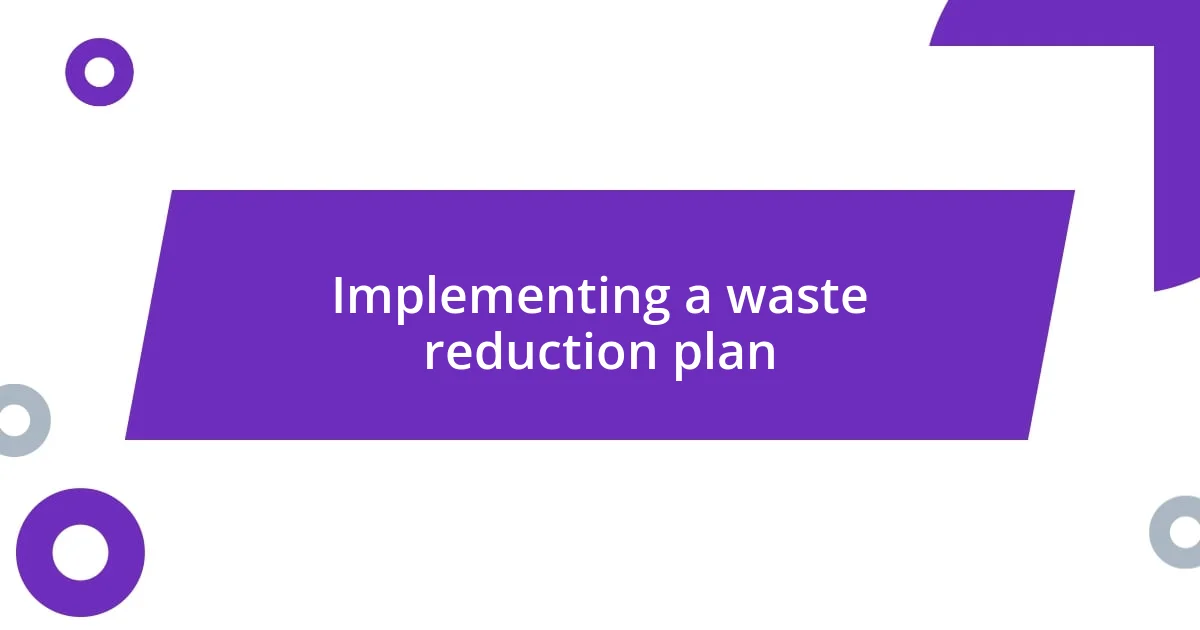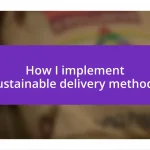Key takeaways:
- Floral waste is a significant issue, with approximately 30% of flowers grown deemed “unsellable” due to arbitrary aesthetic standards, prompting a shift towards sustainability in floral arrangements.
- Choosing sustainable flowers involves sourcing locally, selecting seasonal and organic varieties, and utilizing biodegradable materials, enhancing both environmental impact and design creativity.
- Educating clients about sustainability and implementing a waste reduction plan, including tracking waste, collaborating with suppliers, and repurposing materials, fosters a culture of sharing and appreciation within the floral community.

Understanding floral waste issues
Floral waste is a significant issue that often goes unnoticed amid the allure of beautiful arrangements. My first encounter with this problem came when I participated in a wedding where so many stunning blooms were left behind. It broke my heart to see such beauty tossed away, raising a question in my mind: how much of this could have been avoided?
In fact, it’s estimated that around 30% of flowers grown for sale never even make it to market due to imperfections that are, frankly, subjective. This realization hit home when I discovered that the very flowers I admired were deemed “unsellable” simply because they didn’t fit a certain aesthetic. Doesn’t it feel disheartening to think that so many perfect blossoms are discarded just because they don’t meet arbitrary standards?
As someone who values sustainability, I’ve learned that floral waste extends beyond just unsold flowers. It includes stems, leaves, and even entire plants that are often wasted after events like funerals or corporate gatherings. It made me reflect on my own choices and how I could be part of the solution rather than the problem. What if we could reimagine how we think about floral arrangements, making them a celebration of life rather than a source of waste?

Choosing sustainable flowers
When I started my journey towards sustainable floral arrangements, choosing the right flowers became my top priority. It’s fascinating to realize how much our choices impact not just the environment but also the emotions tied to each arrangement. I remember feeling a deep sense of fulfillment when I began sourcing from local growers who prioritize sustainability. It’s not just about finding beautiful blooms; it’s about supporting a community that nurtures the environment as meticulously as the flowers they cultivate.
Here are some key considerations when selecting sustainable flowers:
- Local Sourcing: I found that flowers grown nearby not only cut down on transportation emissions but also promote local agriculture.
- Seasonal Selections: Choosing flowers that are in-season helped me to avoid the pitfalls of imported blooms, which often come from far away.
- Organic Practices: I’ve begun favoring flowers grown without harmful pesticides or chemicals. Knowing that these blooms support a healthier ecosystem gives me peace of mind.
- Heirloom Varieties: Opting for heirloom flowers often means rescuing unique and historically significant varieties from obscurity, and it adds a charming touch to arrangements.
- Certifications: I always look for certifications like Fair Trade or Rainforest Alliance, which assure me that the flowers were produced sustainably and ethically.
Each of these factors adds another layer to my floral arrangements that speaks not just to the beauty of the blooms but also to the respect for our planet, creating a connection that goes beyond aesthetics.

Using biodegradable materials
When I transitioned to using biodegradable materials for my floral arrangements, I felt an immediate shift in my mindset. Instead of relying on plastic and other non-degradable products, I began to explore alternatives like compostable cellophane and natural jute twine. I remember the first time I wrapped a bouquet in untreated kraft paper. It felt so refreshing to know that the entire arrangement could eventually return to the earth, minimizing the lasting impact of waste.
I was also drawn to looking at common tools in floral design, like foam, which is notorious for contributing to environmental degradation. Swapping that out for biodegradable substitutes like moss or coconut coir changed not only my approach to floral design but also sparked conversations with my peers about sustainability. I vividly remember a colleague’s face lighting up when I explained how easy it is to create beautiful designs without harming the planet. It felt like I was part of a broader movement towards eco-consciousness.
Incorporating biodegradable materials into my arrangements has opened new doors for creativity, too. Each time I brainstorm a design, I get excited thinking about how I can use materials that contribute to a circular economy, such as fruit peels or dried leaves, further adding unique textures while serving a purpose beyond pure decoration. How exhilarating is it to know that creativity can go hand-in-hand with sustainability?
| Material | Biodegradable Option |
|---|---|
| Plastic Wrap | Compostable Cellophane |
| Floral Foam | Moss/Coconut Coir |
| Wire | Jute Twine |
| Non-biodegradable Containers | Clay or Recycled Cardboard |

Repurposing floral arrangements
Repurposing floral arrangements has been a game-changer in my sustainable journey. I remember attending a friend’s wedding where the centerpiece flowers were stunning but quickly ended up as waste. That experience sparked an idea: why not take those gorgeous blooms and create something new? After the celebration, I gathered the remaining flowers and transformed them into smaller bouquets for friends, which sparked joy and gratitude—a beautiful reminder of how repurposing can extend the life of something once deemed finished.
I found that repurposing isn’t just about saving flowers; it’s also about creating connections. One day, I challenged myself to repurpose an arrangement into a wall hanging. Using dried flowers from previous arrangements, I adhered them to a canvas, creating a unique piece of art for my home. It was a rewarding project that unveiled a new side of my floral skills while making a statement about sustainability. Have you ever thought about how a simple change in perspective can give new life to something seemingly spent?
Moreover, I love incorporating a little creativity into gifting. Instead of throwing out the remnants from a larger arrangement, I’ve begun making small gifts for neighbors or co-workers. Not long ago, I crafted mini bouquets from leftover florals and added a note about their original purpose—what a delightful way to spread kindness and sustainability! Each bouquet not only brightened someone’s day but also reinforced the idea that beauty doesn’t have to end when the occasion does. It’s fulfilling to realize that even post-celebration, we can still celebrate life with these floral treasures.

Composting plant waste
Composting plant waste has been an eye-opener for me in my journey toward sustainability. After occasionally tossing scraps into the trash, I decided to take a more thoughtful approach. Transforming what used to be discarded stems and leaves into rich compost not only felt like a small victory but also showed me how those remnants could become nutritious soil for new plants. Isn’t it fascinating how life can come full circle like that?
I remember the satisfaction of digging my hands into a bucket of compost I’d created from floral waste. Every time I sprinkled that dark, crumbly material onto my garden, it felt like sharing a piece of my floral arrangements with the earth. Recycling those vibrant petals and green stems back into the soil enables beautiful new growth. I could almost feel the connection between the past blooms and the fresh life springing forth from the ground. Isn’t it incredible how we can close the loop?
Moreover, composting fosters a deeper appreciation of nature’s cycles. I often find myself contemplating how those once-vibrant flowers can contribute to the vitality of future plants. Each time I gather close-to-expired greens and plant scraps, I see them not as waste but as an essential ingredient in nurturing new life. Have you ever thought about how composting mirrors life itself—transforming the old into something new and beautiful? It’s not just about reducing waste; it’s about engaging in a dance with nature that I’ve come to cherish.

Educating clients on sustainability
Educating clients about sustainability is an essential part of my floral business. I vividly recall a tender moment with a bride who was initially focused solely on extravagant arrangements. When I gently introduced the idea of sourcing local, seasonal flowers, her eyes brightened with understanding. It was as if a light bulb had gone off—she grasped how her choices could minimize environmental impact. Isn’t it empowering to realize that every decision we make, even in floral design, can ripple out towards greater sustainability?
I often share stories about the journey of flowers from farm to vase to deepen this connection. One time, while discussing a project with a corporate client, I mentioned how investing in local farmers not only supports the community but also reduces transportation waste. Watching their faces soften as they absorbed this idea was uplifting; you could feel their commitment to making more eco-friendly choices growing stronger. How often do we consider the broader ramifications of our buying choices? It’s a simple yet profound shift in perspective that can inspire real change.
What truly excites me is helping clients envision floral arrangements that blend beauty with sustainability effortlessly. During a recent event planning session, a client was intrigued by my suggestions to incorporate potted plants instead of cut flowers. We brainstormed ideas about how they could gift those plants to their guests as lasting keepsakes. Imagine guests leaving with a piece of the celebration still alive—a beautiful reminder of both the event and the importance of nurturing our planet. How can we create memories that live on? By intertwining our celebrations with sustainability, I believe we can foster a deeper connection not just to our events, but to our environment as well.

Implementing a waste reduction plan
When I set out to implement a waste reduction plan in my floral business, I started with a simple tracking system. I began recording the types and quantities of waste generated from each event. This exercise transformed my perspective entirely; I found myself thinking about my arrangements not just as art but as a cycle. Have you ever noticed how awareness can spark creativity? By understanding what was wasted, I could adjust my designs to minimize that waste while still delivering beauty.
Engaging with suppliers was another crucial step in my plan. I remember walking through a local flower market, discussing my goals with the vendors. They were eager to help, suggesting ways to obtain just the right amount of blooms that would effectively meet my needs. This collaborative effort not only reduced waste but also strengthened community ties, reminding me why we should all care about where our flowers come from. How often do we pause to appreciate the support systems within our local economies?
Finally, I embraced reusing floral materials. After an event, I started offering to deliver salvaged blooms to nursing homes or local charities. This small act filled my heart with joy; the smiles on residents’ faces when they received those flowers were priceless. Can you imagine the warmth a simple bouquet can bring? By creating a culture of sharing, I realized that reducing waste goes hand in hand with spreading happiness—two powerful outcomes that keep me motivated in this journey of sustainability.














